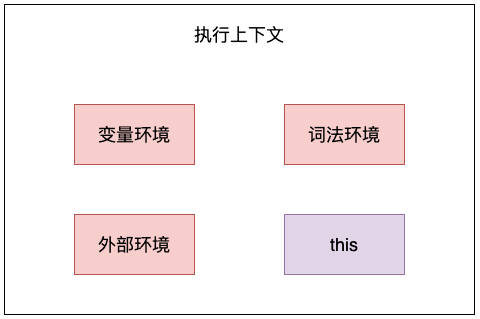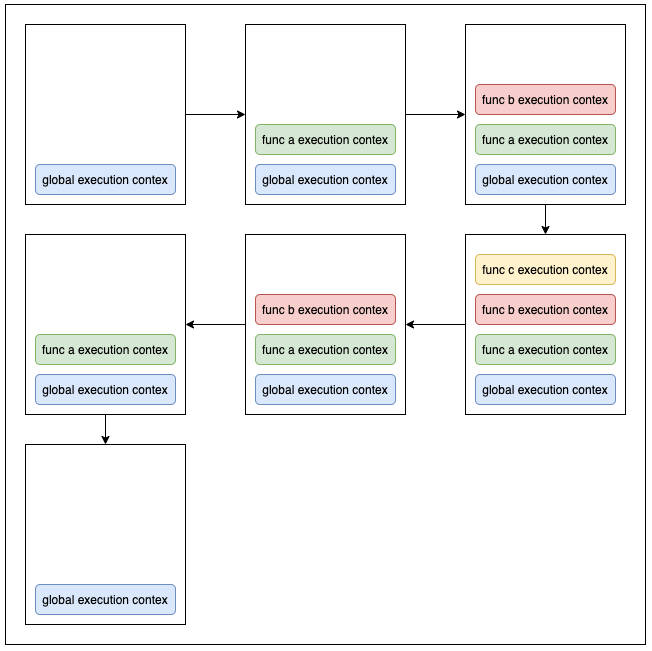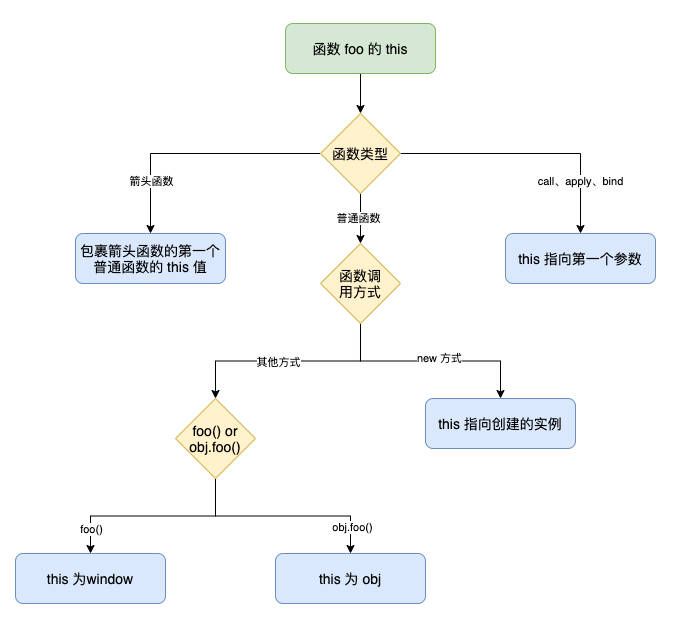this
1. 执行上下文
关于 this,还得从执行上下文说起。在执行上下文中,包含了变量环境、词法环境、外部环境、this:

实际上,this 是和执行上下文绑定的,也就是说每个执行上下文都有一个 this,下面就来看看执行上下文的相关概念。
(1)执行上下文概念
执行上下文是评估和执行 JavaScript 代码的环境的抽象概念,当 JavaSciprt 代码在运行时,其运行在执行上下文中。JavaScript 中有三种执行上下文类型:
- 全局执行上下文:任何不在函数内部的都是全局执行上下文,它首先会创建一个全局的 window 对象,并且设置 this 的值等于这个全局对象,一个程序中只有一个全局执行上下文。
- 函数执行上下文:当一个函数被调用时,就会为该函数创建一个新的执行上下文,函数的上下文可以有任意多个。
- eval 函数执行上下文:执行在 eval 函数中的代码会有属于它自己的执行上下文。
由于 eval 函数执行上下文用的不多,所以这里只介绍全局执行上下文和函数执行上下文:
- 在全局执行上下文中,this 是指向 window 对象的;
- 在函数执行上下文中,默认情况下调用一个函数,其执行上下文的 this 也是指向 window 的。
(2)执⾏上下⽂栈
我们知道,浏览器中的 JavaScript 解释器是单线程的,也就是说浏览器同⼀时间只能做⼀个事情。代码中只有⼀个全局执⾏上下⽂和⽆数个函数执⾏上下⽂,这些组成了执⾏上下⽂栈(Execution Stack)。 ⼀个函数的执⾏上下⽂,在函数执⾏完毕后,会被移出执⾏上下⽂栈。看下面的例子:
function c() {
console.log('ok')
}
function a() {
function b() {
c()
}
b()
}
a()这段代码的执⾏上下⽂栈是这样的:

2. 函数的 this 指向
this 是 JavaScript 的一个关键字,多数情况下 this 指向调用它的对象。
这句话有两个意思,首先 this 指向的应该是一个对象(函数执行上下文对象)。其次,这个对象指向的是调用它的对象,如果调用它的不是对象或对象不存在,则会指向全局对象(严格模式下为 undefined)。
其实,this 是在函数被调用时确定的,它的指向取决于函数调用的地方,而不是它被声明的地方(除箭头函数外)。当函数被调用时,会创建一个执行上下文,它包含函数在哪里被调用(调用栈)、函数的调用方式、传入的参数等信息,this 就是这个记录的一个属性,它会在函数执行的过程中被用到。
this 在函数的指向绑定形式有四种:默认绑定、隐式绑定、显式绑定、new 绑定。
(1)默认绑定(全局环境)
函数在浏览器全局环境中直接使用不带任何修饰的函数引用进行调用,非严格模式下 this 指向 window;在 use strict 指明严格模式的情况下就是 undefined(严格模式不允许 this 指向全局对象)。
注意:在浏览器环境下,全局对象是 window;在 Node.js 环境下,全局对象是 global。
function fn1() {
console.log(this)
}
function fn2() {
'use strict'
console.log(this)
}
fn1() // window
fn2() // undefined需要注意一种情况,来看代码:
var num = 1
var foo = {
num: 10,
fn: function () {
console.log(this)
console.log(this.num)
},
}
var fn1 = foo.fn
fn1()这里会输出 Window 和 1。这里 this 仍然指向 window。虽然 fn 函数在 foo 对象中作为方法被引用,但是在赋值给 fn1 之后,fn1 的执行仍然是在 window 全局环境中。因此输出 window 和 1,它们相当于:
console.log(window)
console.log(window.num)(2)隐式绑定(上下文对象)
如果函数在某个上下文对象中调用,那么 this 绑定的是那个上下文对象。来看一个例子:
var a = 'hello'
var obj = {
a: 'world',
fn: function () {
console.log(this.a)
},
}
obj.fn()在上述代码中,最后会输出"world"。这里 fn 方法是作为对象的属性调用的,此时 fn 方法执行时,this 会指向 obj 对象。也就是说,此时 this 指向的是调用这个方法的对象。
那如果嵌套了多层对象,this 的指向又是怎样的呢?下面来看一个例子:
const obj1 = {
text: 1,
fn: function () {
return this.text
},
}
const obj2 = {
text: 2,
fn: function () {
return obj1.fn()
},
}
const obj3 = {
text: 3,
fn: function () {
var fn = obj1.fn
return fn()
},
}
console.log(obj1.fn())
console.log(obj2.fn())
console.log(obj3.fn())对于这段代码,最终的三个输出结果:
- 第一个 console 输出 1 ,这时 this 指向了调用 fn 方法的对象 obj1,所以会输出 obj1 中的属性 text 的值 1;
- 第二个 console 输出 1,这里调用了 obj2.fn(),最终还是调用 o1.fn(),因此仍然会输出 1。
- 第二个 console 输出 undefined,在进行 var fn = o1.fn 赋值之后,是直接调用的,因此这里的 this 指向 window,答案是 undefined。
根据上面例子就可以得出结论:如果嵌套了多个对象,那么指向最后一个调用这个方法的对象。
那如何让 console.log(obj2.fn()) 输出 2 呢?可以这样:
const obj1 = {
text: 1,
fn: function () {
return this.text
},
}
const obj2 = {
text: 2,
fn: o1.fn,
}
console.log(obj2.fn())还是上面的结论:this 指向最后调用它的对象,在 fn 执行时,挂到 obj2 对象上即可,就相当于提前进行了赋值操作。
(3)显示绑定(apply、call、bind)
显式绑定是指需要引用一个对象时进行强制绑定调用,显式绑定可以使用 apply、call、bind 方法来绑定 this 值,使其指向我们指定的对象。
call、apply 和 bind 三个方法都可以改变函数 this 指向,但是 call 和 apply 是直接进行函数调用;bind 不会执行函数,而是返回一个新的函数,这个新的函数已经自动绑定了新的 this 指向,需要我们手动调用。call 和 apply 的区别: call 方法接受的是参数列表,而 apply 方法接受的是一个参数数组。

这三个方法的使用形式如下:
const target = {}
fn.call(target, 'arg1', 'arg2')
fn.apply(target, ['arg1', 'arg2'])
fn.bind(target, 'arg1', 'arg2')()需要注意,如果把 null 或 undefined 作为 this 的绑定对象传入 call、apply、bind,这些值在调用时会被忽略,实际应用的是默认绑定规则:
var a = 'hello'
function fn() {
console.log(this.a)
}
fn.call(null)这里会输出 hello,因为将 null 作为 this 传给了 call 方法,这时 this 会使用默认的绑定规则,this 指向了全局对象 window,所以输出 window 中 a 的值 hello。
再来看一个例子:
const foo = {
name: 'hello',
logName: function () {
console.log(this.name)
},
}
const bar = {
name: 'world',
}
console.log(foo.logName.call(bar))这里将会输出:world。
那如果对一个函数进行多次 bind,那么上下文会是什么呢?
let a = {}
let fn = function () {
console.log(this)
}
fn.bind().bind(a)()这里会输出 a 吗?可以把上述代码转换成另一种形式:
// fn.bind().bind(a) 等于
let fn2 = function fn1() {
return function () {
return fn.apply()
}.apply(a)
}
fn2()可以发现,不管给函数 bind 几次,fn 中的 this 永远由第一次 bind 决定,所以结果永远是 window。
let a = {
name: 'CUGGZ',
}
function fn() {
console.log(this.name)
}
fn.bind(a)() // CUGGZ手写call
Function.prototype.myCall = function (context, ...arguments) {
context = context || window
let key = Symbol('key')
context[key]=this
return context[key](...arguments)
}
function Person(name, age) {
console.log(name) //'我是参数传进来的name'
console.log(age) //'我是参数传进来的age'
console.log(this) //构造函数this指向实例对象
}
Person.call({name:'a'},'zhangsan',18)
Person.myCall({name:'a'},'zhangsan',18)手写apply
Function.prototype.myApply = function (context, arg=[]) {
context = context || window
let key = Symbol('key')
context[key]=this
return context[key]([...arg])
}
function Person(arr) {
console.log(arr) //'我是参数传进来的arr'
console.log(this) //构造函数this指向实例对象
}
Person.call({name:'a'},['zhangsan',18])
Person.myCall({name:'a'},['zhangsan',18])手写bind
Function.prototype.bind = function (context, ...args) {
if (typeof this !== "function") {
throw new Error("this must be a function");
}
var self = this;
var fbound = function () {
self.apply(this instanceof self ? this : context, args.concat(Array.prototype.slice.call(arguments)));
//把bind方法传入的参数与return 的函数的传参进行合并
}
if(this.prototype) {
fbound.prototype = Object.create(this.prototype);
}
return fbound;
}(4)new 绑定(构造函数)
函数作为构造函数使用 new 调用时, this 绑定的是新创建的构造函数的实例:
function Person(name,age){
this.name = name;
this.age = age;
this.say = function(){
console.log(this.name + ":" + this.age);
}
}
var person = new Person("CUGGZ",18);
console.log(person.name); // CUGGZ
console.log(person.age); // 18
person.say(); // CUGGZ:18可以看到,在上面代码中,this 就指向了构造函数 Person 的新对象 person,所以使用 this 可以获取到 person 对象的属性和方法。
实际上,在使用 new 调用构造函数时,会执行以下操作:
- 创建一个新对象;
- 构造函数的 prototype 被赋值给这个新对象的
__proto__; - 将新对象赋给当前的 this;
- 判断函数的返回值类型,如果是值类型,返回新创建的对象,如果是引用类型,则返回引用类型的对象
function createNew() {
let newObj = null
let constructor = Array.prototype.shift.call(arguments)
if(typeof constructor !=='function'){
return
}
newObj = Object.create(constructor.prototype)
let result = constructor.apply(newObj, arguments)
if(result && (typeof result === 'object' || typeof result === 'function')){
return result
} else {
return newObj
}
}
function Person(name, play) {
this.name = name
this.play = play
}
let p1 = createNew(Person, '拉拉', '爱玩球')
console.log(p1)3. this 的优先级
this 存在很多使用场景,当多个场景同时出现时,就要根据优先级来判断 this 的指向。优先级:new 绑定 > 显示绑定 > 隐式绑定 > 默认绑定
下面来看例子:
function foo(a) {
console.log(this.a)
}
const obj1 = {
a: 1,
foo: foo,
}
const obj2 = {
a: 2,
foo: foo,
}
obj1.foo.call(obj2)
obj2.foo.call(obj1)这里会输出:2 和 1,也就是说 call、apply、bind 的显式绑定相对于隐式绑定优先级更高。
function foo(a) {
this.a = a
}
const obj1 = {}
var bar = foo.bind(obj1)
bar(2)
console.log(obj1.a)这里将会输出 2。通过 bind 将 bar 函数中的 this 绑定为 obj1 对象。执行 bar(2) 后,obj1.a 值为 2。即经过 bar(2) 执行后,obj1 对象为:{a: 2}。
当再使用 bar 作为构造函数时:
var baz = new bar(3)
console.log(baz.a)这里将会输出 3。bar 函数本身是通过 bind 方法构造的函数,其内部已经对将 this 绑定为 obj1,它再作为构造函数,通过 new 调用时,返回的实例已经与 obj1 解绑。 也就是说:new 绑定修改了 bind 绑定中的 this,因此 new 绑定的优先级比显式 bind 绑定更高。
所以,new 的方式优先级最高,接下来是 bind 这些函数,然后是 obj.foo() 这种调用方式,最后是 foo 这种调用方式,同时,箭头函数的 this 一旦被绑定,就不会再被任何方式所改变。
下面是判断 this 指向的流程图:

4. 特殊的 this 指向
除了上面几种 this 指向的规则之外,还有一些特殊的情况,他们的 this 指向与上述情况有所不同,下面就来看看这些情况。
(1)箭头函数
箭头函数会根据其声明的地方来决定 this:
const foo = {
fn: function () {
setTimeout(function () {
console.log(this)
})
},
}
console.log(foo.fn())
// window这里,this 出现在 setTimeout() 中的回调函数里,因此 this 指向 window 对象。如果需要 this 指向 foo 这个 object 对象,可以使用箭头函数解决:
const foo = {
fn: function () {
setTimeout(() => {
console.log(this)
})
},
}
console.log(foo.fn())
// {fn: ƒ}在箭头函数中,如果多层的嵌套,像下面这种情况:
function a() {
return () => {
return () => {
console.log(this)
}
}
}
console.log(a()()())由于箭头函数没有 this ,箭头函数中的 this 只取决包裹箭头函数的第一个普通函数的 this。在这个例子中,因为包裹箭头函数的第一个普通函数是 a,所以此时的 this 是 window。
需要注意,箭头函数的 this 绑定是无法通过 call、apply、bind 方法修改的。且因为箭头函数没有构造函数 constructor,所以也不可以使用 new 调用,即不能作为构造函数,否则会报错。
(2)数组方法
来看下面的代码,在属性 arr 的 forEach 回调函数中输出 this,指向的是什么呢?
var obj = {
arr: [1],
}
obj.arr.forEach(function () {
console.log(this)
})其实输出的仍然是全局对象。
forEach 方法语法如下:
array.forEach(function(currentValue, index, arr), thisValue)其参数如下:
- function(currentValue, index, arr):必需。 数组中每个元素需要调用的函数。
- currentValue:必需,当前元素
- index:可选,当前元素的索引值
- arr:可选,当前元素所属的数组对象
- thisValue:可选,传递给函数的值一般用 "this" 值。如果这个参数为空, "undefined" 会传递给 "this" 值
可以看到,forEach 方法有两个参数,第一个是回调函数,第二个是 this 指向的对象,这里只传入了回调函数,第二个参数没有传入,默认为 undefined,所以会输出全局对象。
除了 forEach 方法,需要传入 this 指向的函数还有:every()、find()、findIndex()、map()、some(),在使用的时候需要注意。
(3)立即执行函数
立即执行函数就是定义后立刻调用的匿名函数:
var name = 'hello'
var obj = {
name: 'world',
sayHello: function () {
console.log(this.name)
},
hello: function () {
;(function (cb) {
cb()
})(this.sayHello)
},
}
obj.hello() // hello执行结果是 hello,是 window.name 的值。立即执行函数作为一个匿名函数,通常就是直接调用,而不会通过属性访问器(obj.fn)的形式来给它指定一个所在对象,所以它的 this 是确定的,就是默认的全局对象 window。
(4)setTimeout 和 setInterval
setTimeout 和 setInterval 中函数的 this 指向规则是一样的:
var name = 'hello'
var obj = {
name: 'world',
hello: function () {
setTimeout(function () {
console.log(this.name)
})
},
}
obj.hello() // hellothis.name 是在 obj.hello () 里被调用的,结果却输出了 window.name。其实,延时效果(setTimeout)和定时效果(setInterval)都是在全局作用域下实现的。无论是 setTimeout 还是 setInterval 里传入的函数,都会首先被交到全局对象手上。因此,函数中 this 的值,会被自动指向 window。